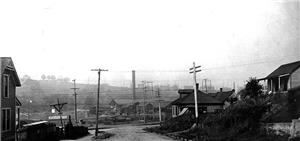Sandy A. Moss, a diesel engineer, was born in Topeka, Kansas, and was brought by his parents to Seattle in June 1900. As a black child growing up in Seattle during the early years of the twentieth century, he witnessed the Dearborn Regrade, which caused the family homestead on Beacon Hill to fall into the mud and become "nothing but matchsticks." This account was excerpted from Esther Mumford's interview with Sandy Moss, done on April 24 and 25, 1975 for the Washington State Oral History Project.
Excerpt from the Interview
"I was brought by my parents to Seattle, Washington, June 17, 1900. And I spent all my early years here in the city of Seattle. We lived out, well ... it’s where the south end of town is now. It’s on the south end of Beacon Hill. And we lived there for, well up until I was six years old. And then we moved in closer into Seattle on the north end of Beacon Hill, which was only about a mile and a half, two, from the center of … Seattle as Seattle was in 1906.
"My father purchased two lots there on 11th and Charles Street, and we lived in a tent, that summer and that winter. The first summer and winter we lived in a tent there. And there was four of us children and that was just like camping to us. ‘Cause in the winter time the icicles was out from the edge of the tent to the ground … we’d go out and break icicles and put ‘em in the pan, and then put ‘em near the stove to melt to get water to drink.
"The next year, my father, well in that year 1907, was, the next year they started to cut and sluice Dearborn Street through. That was solid ground from Rainier Avenue down to 8th or 9th Avenue there, it was a big hill in there and they sluice and cut that all out and built a bridge over there…the first bridge they built was a wooden bridge. And then in later years, 10, 12 years later they built the concrete bridge that ... exists there now.
"And this house when they were cuttin’ this dirt away to make the bridge, why they were a lot of houses on both sides of 12th Ave. They had to move those out. Well my father bought one of those houses, was a six-room house, and we moved it on our lot at 11th and Charles. And that was our family home, for oh, about the next 15 years.
"The foundation bed on this hill was blue clay that they used to make bricks with. And there was a brickyard between 12th Avenue and Rainier Avenue and between Weller Street and Dearborn Street. They got their clay out of this hill and there was a tunnel through under where they cut the hill out to put the bridge in and they run little trains in there, narrow gauge it was, a little steam narrow gauge train to haul the clay to the brick yard.
"And in mining this clay and diggin’ it out, it underminded the west side of Beacon Hill, the Northeast corner of Beacon Hill. And the land in there commenced to, the topsoil commenced to slidin’, the topsoil through there was about 15 to 20 feet. And there was about 25 or 30 houses along through there, on 11th and 10th and 9th Avenue, down to 8th and it got so dangerous that the city condemned all the houses and told us that we have to move out.
"Well, some of the people moved out right away, but my father and some of the other, old timers there, they, we called them, my mother called them the die-hards. They wouldn’t move, they was going to sue the company and sue the city…and make ‘em stop diggin’ this dirt out. Well, it was sliding so bad that they had stopped diggin’ the clay out when they cut through Dearborn to put the bridge in. So heavy in the winter, when it was heavy rains, why then, that’s when the earth commenced to movin’ there. And it got so bad, that everybody had to move out of their houses. And some of the folks moved their houses away.
"But my father and half a dozen others wouldn’t move their houses. They were ... they said they were going to sue the company and the city. But it got so bad we had to move out of the house and we moved a block and a half from there, where our house was visible. We could look out and see our house. And one morning we looked out there and I run and told my mother that our house was gone.
"So we walked over to the brink of the hill and looked and the house was three blocks down below, and it was about two hundred feet lower and it was just a bunch of matchwood down there. It was all broke up into, like you would step on a apple box and crush it. Well, we lost our home all together, we had no furniture in it, but the house was a complete loss. Then the city had condemned all the property, so they taken the property over and …the owners got some out of it, from the city, but not enough to pay for what the homes and the property was worth."

